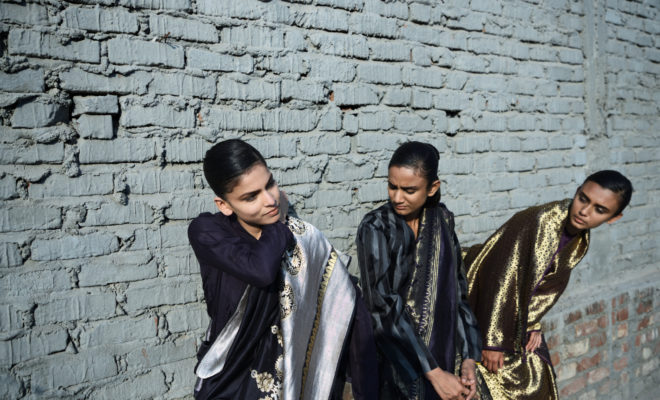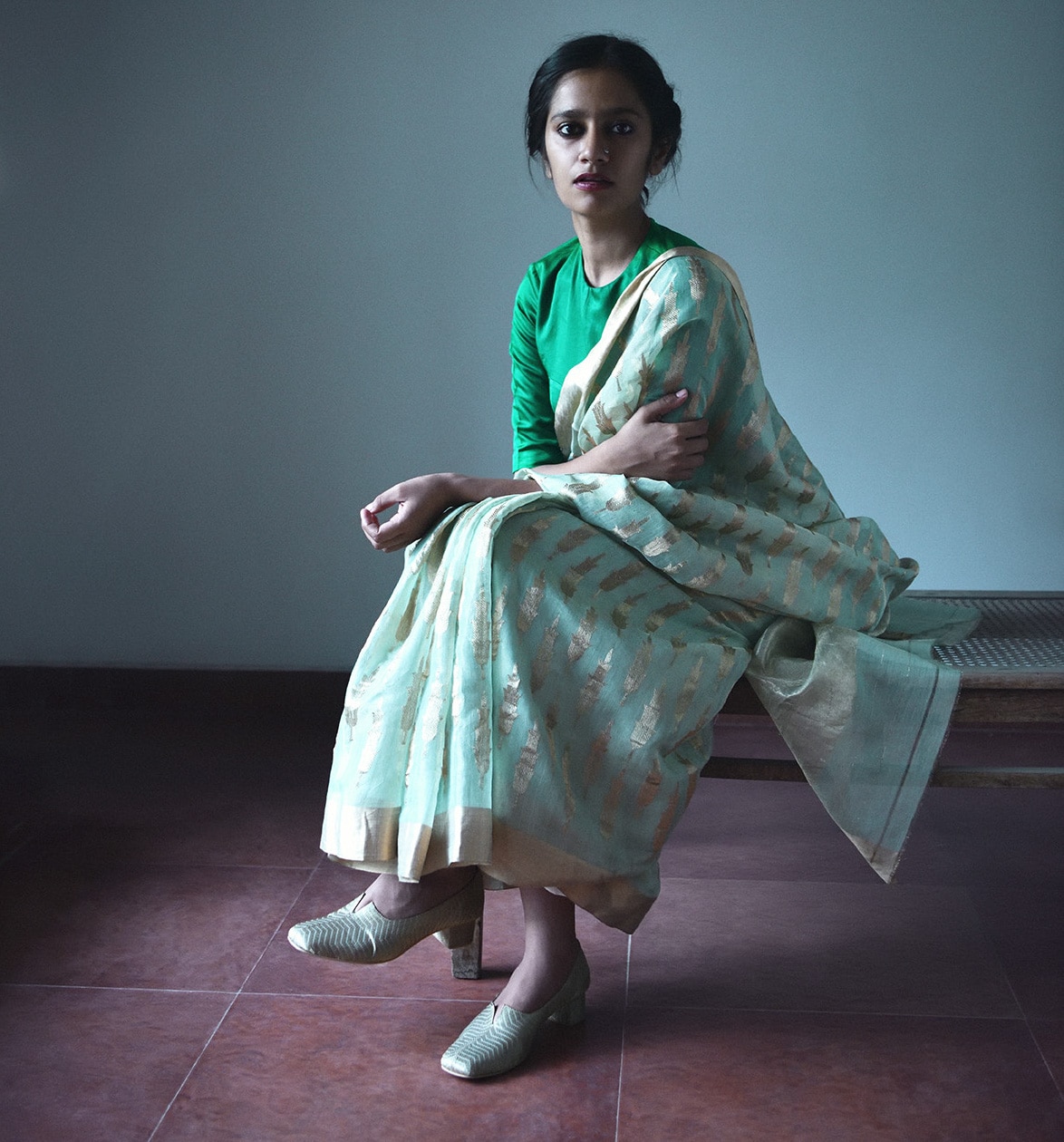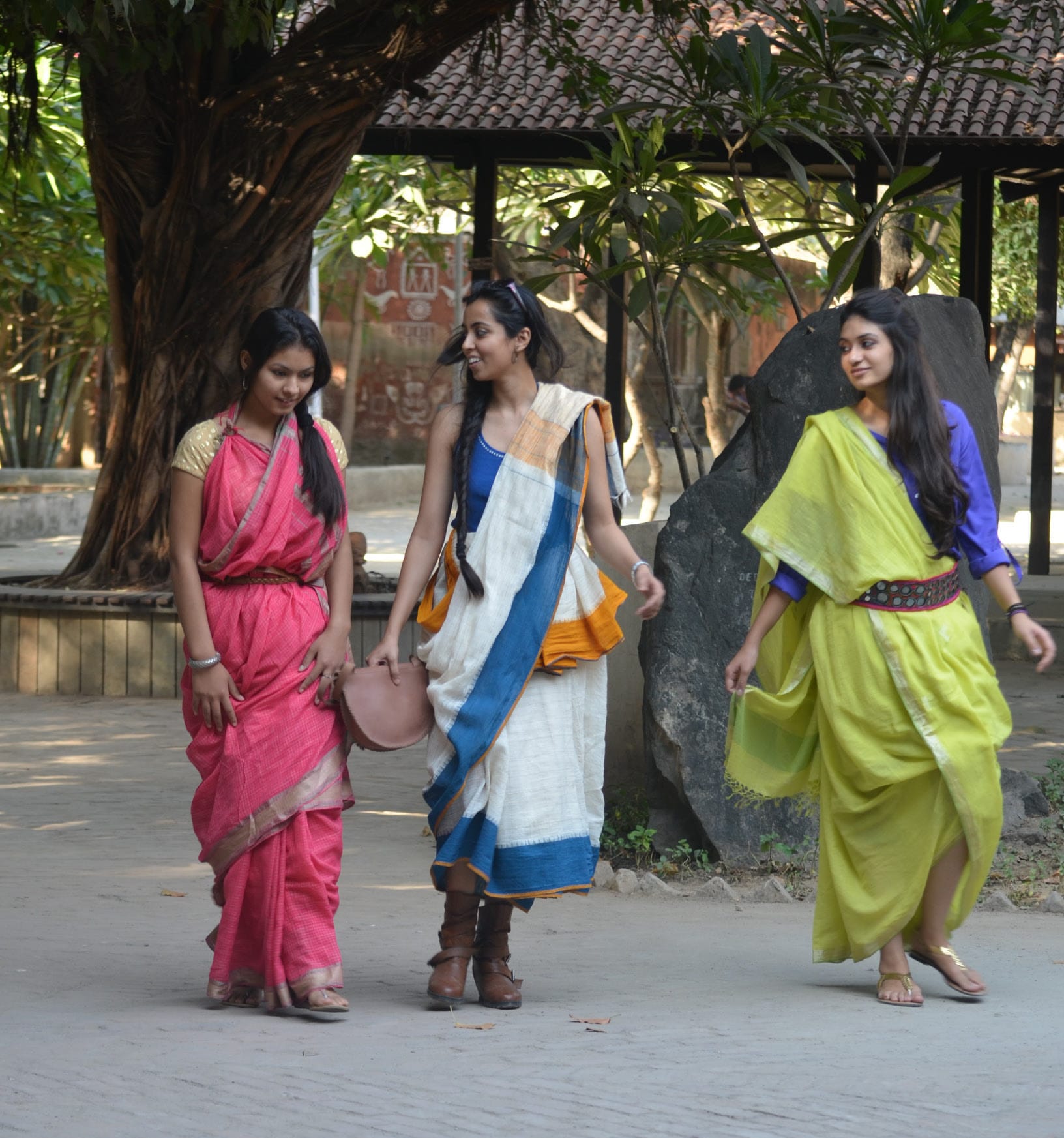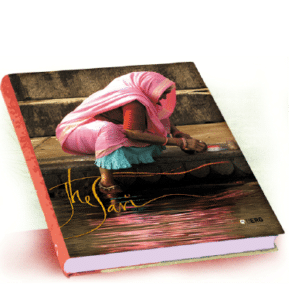Life
How the Sari Changed the World

Credit: Raw Mango
While the sari traces its history to the Indus Valley Civilization in 2800 BC and has been an integral part of mainstream dressing in the sub continent ever since, it has also undergone several transitions — perhaps more than any other garment in modern history.
An exhibit at MOMA placed the sari alongside the most iconic fashion garments of the past century, such as the Little Black Dress and the white shirt. But can the garment, which is slipping out of mainstream fashion in India, be revived?
In the fall of 2017, the Museum of Modern Art (MOMA) in New York held its first fashion exhibition since 1944, titled: “Items: Is Fashion Modern?” featuring 111 garments that have left an indelible mark on fashion in the 20th and 21st century. The exhibit features everything iconic from a Levi’s 501 jeans and the little black dress, to a baseball cap, hijab and the sari — a garment from the Indian subcontinent that in today’s world is at once both stereotypical and neoteric.
A sari by Delhi based designer Sanjay Garg of Raw Mango is featured at the exhibit. Garg says: “It is heartening that the sari is being featured alongside a Levi’s jeans or a Little Black Dress. A sari is one of the most evolved garments and that’s why it survived more than 4,000 years. It is a language that did not disappear and it had to be recognized.”

Credit: Raw Mango
Rta Kapur Chishti, a sari historian, textile scholar and a pioneer in sari revival says: “The sari is the most visible unstitched garment though there are many others, such as the sarong, but they have some stitched edges. It may not have ‘changed’ the world, but it has contributed in providing innumerable ways of draping an unstitched garment and that is its most unique contribution.”
Chishti, who has authored books on sari and its various drapes, says, “I have featured 108 wearing styles in the last volume titled ‘Saris- tradition & beyond’ published in 2010, but I am sure there are many styles in India that have still not been documented and presented.”

Credit: Rta Kapur Chishti
While the sari traces its history to the Indus Valley Civilization in 2800 BC and has been an integral part of mainstream dressing in the sub continent ever since, it has also undergone several transitions — perhaps more than any other garment in modern history. During the past few decades in urban India, however, the garment has lost much of its appeal, with many women opting for western wear, often citing reasons of ease and practicality. In recent years, however, as identity and assertion emerge as the the new lingo, the sari is experiencing a resurgence as both a fashion as well as communal statement.

Mukulika Banerjee: “A sari is a piece of textile until it is worn, wrapped, tucked and draped.”
Dr Mukulika Banerjee, director, South Asia Centre, London School of Economics and Political Science, and co-author of The Sari, which explores how the garment survived the vicissitudes of time and practicality, says: “The Indian sari is a unique fashion garment. It is an unstitched garment, a piece of cloth about five meters long, which is teamed with a blouse and underskirt. But these are recent innovations from the last century. A sari is a piece of textile until it is worn, wrapped, tucked and draped. It does not follow the fashion route as we have come to know it through fashion theory, from the catwalks of haute couture to high street retail clothing stores.”
Adds Banerjee: “For the majority of women who wear saris, the choice of what and how to wear a sari involves a number of choices, which are circumscribed by color, status, occasion, personal aesthetic judgment, age, etc. In this book we explore the social life of a sari and the ways in which women who wear them (which numbers at least 200 million in India) wear it and construct it as a fashion garment in their own ways.”
Banerjee says her work “explores the beauty, adaptability and personality of India’s most iconic garment. It presents intimate portraits of women in India today as well as an alternative way for us all to think about our relationship to the clothes we wear.”
SARI REVIVAL
The sari is witnessing an urban revival in which the item of clothing is also viewed as a power statement. Although, the sari is far from becoming daily wear for professional women in urban India, it is back in the dialogue. The resurgence is seen not just in India, but globally too. Earlier this year, the Indo-American Heritage Museum in Chicago, Illinois, presented an event, titled “Unstitched: The Art of Sari Draping.” The event, designed to promote diversity in America, included a kaleidoscopic presentation of the history of sari and women from the community modeled different drapes.
Recently, Google launched the #wewearculture platform as part of its Art & Culture section with the aim of collaborating with museums and fashion houses to digitize the world’s cultural treasures and to create a searchable guide to a collective archive of some 30,000-fashion pieces. Bringing sari into this narrative is a Bengaluru-based creative agency, Border & Fall, which has, as part of the project, created an online exhibition showcasing some of the lesser known sari drape styles from India. It features nearly 60 different drapes from 15 states in India, reflecting the many facets of the sari.
Chishti says that the sari, which was facing a precipitous decline, is experiencing a revival: “In the present context in India, it has a growing presence in the courts and boardrooms of multinational companies and banks, both as an assertion of identity and power play. In the western world, most Indians have taken to western wear and jeans, which are present everywhere, whether they suit the climate or not. This is partly a way of merging with the culture of the country they are living in and not being stared at and also keeping the sari for formal occasions only.”
While she admits that in certain professions in India, the sari remains a protocol dress, lately there has been a revival among young, expatriates and others genuinely interested in the history and significance of the sari.
Chishti, who runs, The Sari School in New Delhi at which she offers workshops on sari draping, says she is seeing renewed interest in the sari amongst younger women: “As the final volume of Saris – Tradition & Beyond was being completed, The Sari School was initiated in 2009 as a means of sharing whatever we had learnt with whoever was interested, as the book was limited to only readers. We have had students of design, media, bureaucrats, lawyers, brides, executives, etc. There is a growing interest in The Sari Workshops, which are held either as participatory workshops or demo workshops for large groups of up to 1,000 in the audience.”
The rising curiosity is also apparent in emerging new social trends. In India, as part of its experiential series, Airbnb offers sari-draping workshops to clients. The classes are held at Chishti’s studio, where she teaches enthusiastic young women everything from Kerala’s Mohiniattam style of sari wearing, which does not require a petticoat, to Bengal’s Dhokna Jalpaiguri drape.

Even as Indians turn to Western garments, a few Westerners have begun embracing the sari. Linda Lynton, author of The Sari – Styles, Patterns, History, Techniques, says her interest in the garment was piqued when after marriage to an expat Indian, she went to India to meet her in laws for the first time and was gifted a sari.
She says: “I found it fascinating that when a gift sari was locally made my host would tell me all sorts of things about it. But other times, they would shrug and say, ‘Oh, I bought this when I was on vacation in Kanchipuram,’ or wherever they had been. So I started looking for information about saris in general and found very little that satisfied me. So being a freelance writer at the time, I decided to research and write my own book. You could say it was downhill from there.”
At the newly opened Migration Museum in London earlier this year, an exhibition titled “100 Images of Migration,” on crowd sourced pictures included a stand out picture of a sari shop in Leicester. It could as easily have been located somewhere in Punjab instead of the United Kingdom. Another picture showed an Indian grandmother wearing a sari with a Brit style buttoned up cardigan. The picture at once shows the amalgamation that migration fosters. The sari surfaced only occasionally among migrants during weddings or festivities. The alacrity with which Indians took to western wear forced many sari shops across the United States and the United Kingdom out of business.
But with the changing global rhetoric on race and migration, the sari is being resurrected as a symbol of identity. Two years ago, Tanya Rawal, an Indian American professor at the University of California, launched a campaign titled #SareenotSorry that went viral. Tanya told Buzzfeed: “I wanted to perform at the intersection of the multiple social identities and political systems that shape my everyday life.” Amongst the many photos that Rawal posted was a picture of her in a sari holding a placard that read: “I don’t look like a terrorist.”
But not all immigrant fashion may be inspired by a need for identity. Dallas-based fashion bloggers Payal and Priyanka who run the very popular Bollywood fashion blog, High Heel Confidential, have been promoting the sari on their website as well as on social media. The duo regularly post pictures of themselves in various weaves from India and are also producing a short film The Sari Series. Is their love for saris derived from a natural affinity or their immigrant identity? Payal Parija says, “When we started wearing saris again, it wasn’t to make a political statement. That narrative wasn’t on our radar at all. Lately, for the past couple of years, we have been re-discovering the many textiles, weaves etc. And gravitating to wearing a sari instead of just admiring them was natural progression for us. What started as an obstacle, where we thought it’s so hard to drape a sari, became a challenge and we began contemplating how else can we drape the sari?”
Parija adds, “The fact that it puts us in touch with our immigrant identity in this political climate is an added bonus.”
SARI AS IMMIGRANT IDENTITY

Banerjee says: “Being modern does not have to mean a growing homogenization, or sameness, the blue jean, gap, drabness of global modernity. The sari did not have to be a stark rejection of a particular vision of modernity, of Americanization and before that of British colonial forms with their attempts at a hegemonic rationality of appearance. What was required instead was precisely the seamless continuity that allows the sari to change, but to remain in place, that the sari can encompass and include that which was required by change, but by virtue of this continuity within a region to create a more subtle less alienated form of modernity that does not require a surrender of the local to the global.”
While the socio-political significance of the sari cannot be ignored, Raw Mango’s Garg feels that it is but one parameter from which to view it: “Sari is the most versatile garment, it doesn’t need sizing, is weather appropriate, can flatter all forms and can also be molded to individual preferences.”
Adds Lynton: “The sari is such a distinctive garment, and so flattering for just about any woman who wears it, it is not surprising that it is one of the emblems of India and Indian society. Speaking as a Westerner, it is also fabulous that no matter how much weight one gains or loses, the sari always fits! I hope Indian women do continue wearing this mode of dress. It is certainly comfortable and practical in the South Asian climate and it always looks elegant.”

Linda Lynton: “Clearly the sari as a mode of dress came from somewhere, and the vedic interest in cloth not pierced by a needle lies behind the traditional Indian dress code.
THE POLITICS OF SARI
Many sari historians argue that a sari has always been a political statement not just in the West, but also in India. Designer Rina Singh, who specializes in historical costume studies and is the brain behind Eka, a sustainable fashion brand that retails globally, says: “Sari as a political symbol is nothing new. For ages our own politicians have been wearing a sari. Khadi was a big idea that promoted ahimsa through clothing if you look at it.”
Garg, who during the preview of the exhibit at MOMA also delivered a talk on sari at the Fashion Institute of Technology, says that the sari should be understood from a socio-political stadpoint, especially in the West, asserting that it’s not possible to separate fashion from cultural taboos and traditions.
However sari advocates lament that many Indian women are shunning the sari without understanding it. Rina Singh says: “I have nothing against Indian women wearing a pair of jeans or a dress. It is fashion democracy. What is worrying is when women wear western fashion even though they do not identify with it.
“If a gown is an expression of celebration for you, go for it, but if it is done just to fit in then that’s a problem.”

Eka’s Rina Singh: “If a gown is an expression of celebration for you, go for it, but if it is done just to fit in then that’s a problem.”
A survey last year by Border&Fall on social perceptions of the sari found that 98 percent of respondents were unaware of the different drapes of a sari and 94 percent admitted to wearing a sari only occasionally. But a whopping 94 percent of women said that they would miss the sari if it were to disappear totally. The emotional connection, according to Garg, may explain why the sari remains popular amongst Indians: “When I go to Sri Lanka, I feel saddened to see how women have replaced their native dress sari with a nightie! I feel glad that this hasn’t happened in my country.”
Payal Parija believes that the sari loses its significance among the first or second generation immigrants because of ignorance: “People (in the west) don’t know yet that there is a variety of saris available. Most people I talk to think that there are only Kanjeevaram or Benarasi and hence wouldn’t really wear that on an everyday basis, because it is really heavy and ornate. If they knew that there are so many other kinds of weaves and materials that can be worn on a daily basis, they probably would want to try it.”
She adds: “We also have to consider the time that we are in. When folks arrived in the West, it was easier for them to blend in by wearing western clothes. That practice is still prevalent among immigrants. I would say that it is changing though. Now, people have more open minds and instead of looking down at an attire that they might have called odd before, they want to know more about it.”
Some Indian designers are nurturing dreams that with its many interpretations it is possible to project the sari as a global garment. Says Singh: “There is a new-found confidence amongst Indians about their heritage and today we are in a mood to say that if we can buy a Zara or a Stella McCartney or a Rado, how about the West too look at our design sensibilities. We are happy to bring our craft on the table and ask if it speaks to them.”
But the sari’s global appeal is limited, Garg admits: “Sari is a garment from the Indian subcontinent and it would be unfair to expect that it rule the world. It’s like asking if sari can become the trouser? And well, the answer would be, probably not!”
Even though the sari is growing in popularity, it still has the baggage of ethnicity, Garg points out: “Today yoga is seen as yoga and not as a migrant exercise, but with sari its’ not the case.”
Nevertheless, Banerjee says: “The sari remains one of the few draped garments that is widely worn by millions of women. It provides an alternative to the homogenized look of tailored designer-led clothing! It continues to remain the garment of choice for celebrities, working women (with their ‘power saris’ for meetings) and agricultural and construction labor in India. This is because the sari is considered versatile and elegant — it allows them to adapt their look, as the situation demands it, and highlights the beauty of the female form.”
Eventually, Garg says: “Fashion is all about how you adapt and interpret it.” He recalls, “I was in London recently and met a Singaporean woman who wore her sari as a hijab. Her blouse had long sleeves and she had covered herself totally with the drape. This was her interpretation of sari and it for me pretty much summed up how much you can do with this garment.”
[wonderplugin_gallery id=”13″]

You must be logged in to post a comment Login